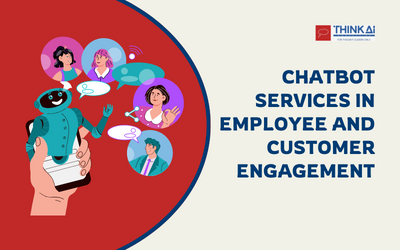A business can reach its full potential once it can engage with its employees and customers. With the ever-evolving digital landscape, companies have embraced high-end technology and innovative tools to connect more deeply with their employees and customers.
One such widespread technology is artificial intelligence. Companies often rely upon chatbots, software applications that mimic human conversation. Using this service allows them to engage with their customers and employees efficiently.
This blog will highlight the use of chatbot services in employee and customer engagement.
AI-powered chatbot services have become an integral part of employee and customer engagement. Companies often rely upon chatbot services to communicate with their employees and eradicate any form of miscommunication. Similarly, customer communication has also improved immensely with the help of chatbots.
Chatbot services aid in multiple operations related to engaging with employees. They help communicate with employees and allow the organization to make other employee-related operations easier.
Chatbots for training and onboarding process
With the help of chatbots, organizations have facilitated employee training and the onboarding process necessary to welcome an employee. With the help of chatbots, companies can create a more interactive learning session that helps impart essential information. Furthermore, this also elevates the quality of employee training and ensures that the training material is more interactive and understandable.
This interactive session can include Q/As that help address any queries that the new employees might have. This interactive approach helps the company connect more deeply with its new employees and helps in engagement. For instance, chatbot services for healthcare often include training healthcare professionals regarding the policies of the healthcare institute so that they can conduct their day-to-day activities efficiently with complete information regarding hospital policies.
Streamlining the department of communication
To function efficiently within their chosen industry, a company must maintain communication between all its departments. With the help of chatbots, companies can streamline their internal communication system. This service allows all employees within the company quick access to information and resources. Furthermore, with the help of chatbots, the company can make its communication system more transparent, which allows accessibility regarding information and eradicates any form of miscommunication between departments.
For instance, with the help of chatbots, the employees of an organization can clarify any queries they might have regarding company policies and HR-related queries. Chatbots are automated communication systems that mimic human responses and answer all employees’ queries. Using this not only helps the organization engage with its workforce but also allows them to save time. It also reduces the administrative burden on organizations and will enable them to use that resource in other aspects of the company.
Seeking feedback
A company’s success depends upon its ability to improve constantly. This constant improvement depends on the feedback it receives from its workforce. With the help of chatbots, companies can create a simple channel that collects employee feedback through polls and surveys. Using this allows for an unbiased approach in terms of gathering feedback.
Also, with the help of chatbot services, the company can seek real-time insight into the mindset of their workforce and understand their preferences. It allows the company to anticipate the future of its role as an employer and will enable it to engage more deeply with its workforce.
Similarly, companies also use chatbot services to enhance their customer communication systems. Chatbots also help companies engage more deeply with their customers by providing a personalized experience.
Chatbots in customer service
Chatbots most commonly help in customer service. Using the service enables the company to provide round-the-clock customer support and ensures that they receive assistance anywhere. The entire process would include answering any queries that the customers have about the product or the service offered by the company.
Furthermore, with the help of chatbots, the company can resolve any technical issues already pre-programmed into the software. Since the chatbot mimics human conversation, the interaction becomes more accessible for the customer to comprehend and receive answers to their queries. Also, in regards to customer service, with the help of chatbots, the company can handle routine customer interactions to assess their satisfaction levels with the brand.
Chatbots provide personalized experiences
Since chatbots mimic human interaction, they can also analyze customers’ preferences through data analytics. By leveraging data analytics and machine learning algorithms, companies can employ chatbots to analyze customers’ preferences and deliver personalized services and products based on that analysis. With the help of chatbots, a company can engage more deeply with its customers and anticipate their needs and demands. The AI-powered chatbot service also equips them to fully understand the unique needs of their clientele and provide them with personalized experiences so they can connect more deeply with the brand.
Conclusion
Companies rely upon chatbot services to optimize operations and connect more deeply with their employees and customers. With the use of chatbots, companies elevate their ability to use high-end technology within their services and remain innovative in their approach toward business. With the help of chatbot services, the engagement between the organization and its workforce becomes easier, highly organized, and transparent.
On the other hand, regarding customer services, chatbot services help an organization engage with its customers and maintain the trust and loyalty established between the two due to the personalized experiences provided to customers by the brand.

